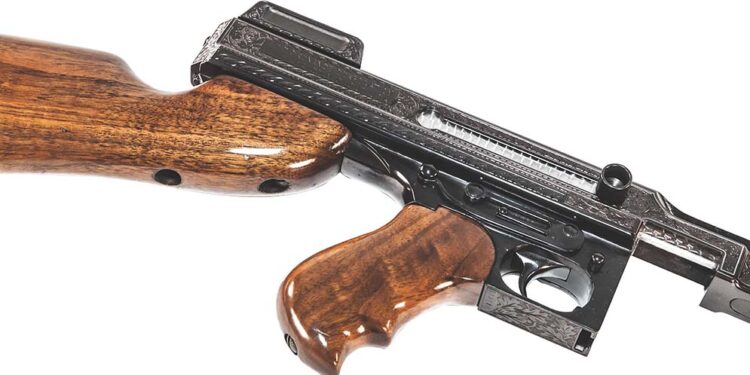By Tom Davis, Jr.
There are many different variations of the Thompson submachine gun. What started life as a “trench broom” in 1921 has morphed into several different models and sub-models from different generations of production. For many, the differences are easy to recognize. There are the guns with round drums and pistol grips like Eliot Ness used in The Untouchables. And guns with the long stick magazine and sling like Sgt. Saunders carried in COMBAT! How those black & white television shows of the 1960’s made everything so easy. However, those of us in the Thompson community understand that nothing is simple with the Thompson gun. Pages of many books have been filled with information about the gangster and World War II Tommy guns. This story is different; it is about a lesser known and greatly misunderstood Thompson variation. One manufactured, some argue assembled, when the Tommy gun was fading fast from the limelight of World War II. These are the “NAC Thompsons,” sometimes referred to as the “crate” Thompsons. The mis-information about this variation began almost immediately after examples became available on the civilian market. The reason for the confusion is simple: the receiver markings. Some of these NAC Thompsons had genuine Colt’s Patent Firearms Manufacturing Company receivers, and were so marked! The confusion this caused exists to this day. The below information should lessen the many misunderstandings. First, a little history…

Auto-Ordnance Corporation (AOC) went through a change of ownership on July 21, 1939. Wall Street underwriter J. Russell Maguire assumed control of AOC and a new era for the Thompson gun commenced. Maguire sensed a major war was brewing in Europe and contracted with Savage Arms Corporation of Utica, New York, in December 1939 to place the Thompson gun back into production. AOC later opened its own factory in Bridgeport, Connecticut.
Production of the Thompson gun ended in February 1944. Savage Arms packed away all the left over Thompson parts, gages, prints and tooling, including all the left over items they obtained from the earlier Colt era production, and shipped these assets to AOC. Soon after production ceased Maguire took the first of many steps to convert AOC into a post war company. The corporate name was changed to Maguire Industries, Inc. The Thompson gun became a product of the new Auto-Ordnance Division of Maguire Industries, overseen by an employee who was hired by General Thompson during AOC’s earliest years, George E. Goll. The Auto-Ordnance Division was but one of several divisions in Maguire Industries. Thompson guns were assembled from left over Auto-Ordnance Bridgeport plant receivers and frames and sold for several years. These Thompson guns form another often misunderstood Thompson variation and are usually referred to by collectors as the “AC” variation or model. Fortunately, these guns are for the most part easily identified because the “U.S.” markings were ground off the receiver and a letter “C” was stamped over the numeral 1 in the receiver marking “A1” to form the new “Model 1928 AC” nomenclature. Please note the qualifiers “for the most part” and “usually” – exceptions are the rule after 1944. Like the NAC Thompsons, documented sales of the “AC” guns appeared to be primarily to law enforcement agencies. For the record, the NAC and “AC” variation guns were not and are not US military issued World War II Thompson guns – regardless of the receiver markings. And as you will see, their history is intertwined with the NAC Thompson guns.
Maguire Industries did not fare well in the post war business environment. By 1949, Maguire Industries was having severe financial problems. George Goll had retired a few years earlier and Thompson sales had ceased. Russell Maguire reached out to former AOC Vice-President Frederic A. Willis to sell the Thompson assets. These assets included all rights and interest in the Thompson gun Maguire acquired when he took control of AOC. Willis found a buyer – the Kilgore Manufacturing Company of Westerville, Ohio. Kilgore was an established toy company that had become heavily involved in the production of pyrotechnic munitions during World War II. Documentation from the then president of Kilgore Manufacturing revealed the original plan was to sell the Thompson assets to a foreign country, but the sale never took place. Kilgore transported some of the Thompson assets to its plant in Ohio and appeared to have an alternate plan to manufacture and market the M1A1 version of the Thompson. No new manufacturing of parts took place but several guns, assembled from parts or found complete in the crates, were sold. A large explosion of Kilgore munitions on May 19, 1950, in South Amboy, New Jersey, exposed the company to numerous lawsuits. Kilgore reached out to Frederic Willis to sell the Thompson assets – again. Willis formed a syndicate of buyers and purchased the Thompson assets from Kilgore on August 7, 1950. There is no indication Willis or his investment syndicate did anything with the Thompson assets during their period of ownership.
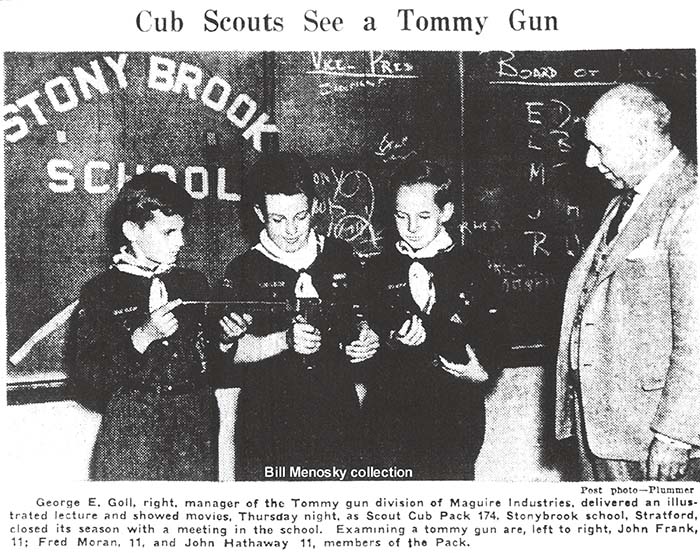
The Willis syndicate sold the Thompson assets to Mr. George Numrich, owner of Numrich Arms Company of Mamaroneck, New York (now located in West Hurley, NY) on October 23, 1951.
Some Thompson pundits espouse the AOC formed by General Thompson in 1916 ceased to exist at the end of World War II. Or the Auto-Ordnance Corporation was purchased by Numrich in 1951. Nothing could be further from the truth. The original Auto-Ordnance Corporation exists today and is located in Dallas, Texas. The Auto-Ordnance name was simply abandoned when the corporate name was changed to Maguire Industries in 1944. The corporate name was changed again in 1961 to Components Corporation of America (CCA). As with the Auto-Ordnance name in 1944, the Maguire Industries name was also abandoned. CCA is a privately held company whose majority shareholder is Cary Maguire, the son of Russell Maguire. CCA is not involved in the production of firearms and does not claim any ownership rights in the Thompson gun. That corporate product was sold off (to Kilgore) long ago.
When employees of Numrich Arms Company (NAC) began unpacking the crates of physical assets, they found a number of complete guns, and sufficient parts to assemble others. Included in this catch of parts were model of 1921 and 1928 Thompson receivers manufactured by Colt’s in 1921/1922, and Savage Arms in 1940/1942. Model M1 and M1A1 receivers were also present. Hence, the reason for this brief history lesson.
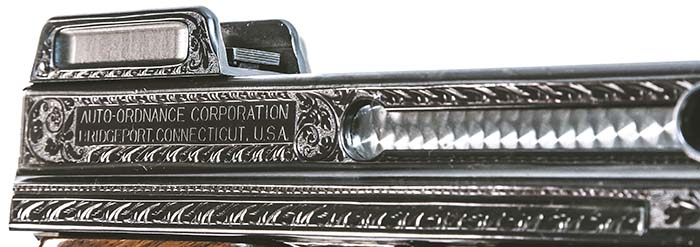
THE INVENTORY
The number of weapons found by George Numrich requiring registration with the Internal Revenue Service (IRS) has been an ongoing point of debate. The numbers of 86 and 95 guns have been cited with some authority for many years. The difference could be the number of Thompson guns found versus the number of Thompson guns plus other guns found requiring registration. Complete guns found in the crates have also been reported. Many have assumed that Thompson guns straight from the production line were found. Unfortunately, no details exist of exactly what type of complete guns were found but the below information may go a long way toward an explanation of these complete guns.
Recently, an inventory of weapons owned by the Auto-Ordnance Corporation, dated July 26, 1934, was found. The July 26, 1934 date is familiar to most in the Class Three community as that is the day and year the National Firearms Act (NFA) was signed into law by President Franklin D. Roosevelt. This law restricted the private ownership of automatic weapons, short barrel rifles, silencers and weapons classified as “any other weapon” by registration and taxation. It is believed this inventory was conducted to insure AOC was in compliance with this new law.
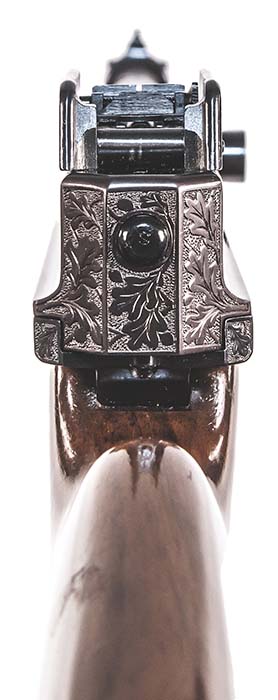
The beginning inventory lists 9 Birmingham Small Arms (B.S.A.) prototype Thompson submachine guns as being directly possessed by AOC. Included are 5 of the “new” B.S.A. models and 4 of the earlier and now “obsolete” B.S.A. models. Also shown is one “Thompson Submachine Gun, assembled from Colt’s scrapped parts, frame No. 2308, and receiver No. 7308.” Two more Thompson guns are also listed, one “belt fed” and one “for box magazine” without serial numbers.
The earliest prototype Thompson guns were manufactured one at a time at the Warner & Swasey Company in Cleveland, Ohio. These are mostly marked “Model of 1919” and so referred to by those that study the Thompson gun. The inventory of the “Cleveland made” Thompson guns begins at serial number No. 1 and ends at No. 40. However, not all numbers are accounted for. Only 33 “Cleveland made” Thompson guns remained in AOC inventory in 1934. Missing guns include Nos. 6, 9, 11, 17, 36, 37, and 38.
The inventory also contained weapons that were not Thompson guns. Firearms requiring government registration included (one each) Hotchkiss, Lewis and Vickers machine guns and eight (8) Maxim silencers. In addition, the inventory contained a listing of guns that were owned by AOC but consigned to individuals and companies. These are not included in the below total because it is not known if any of these weapons were ever returned to AOC.
How many of these 56 weapons noted on the 1934 inventory that required federal registration were packed away in the crates when sold to George Numrich is unknown. This inventory could have easily grown in number after 1934 with the known Savage M1 and 9mm prototypes, the AOC Bridgeport T2 prototypes and AOC Model of 1929 B.S.A. prototypes. Other known prototypes constructed after 1934 include at least two AOC experimental rifles in .30 caliber and .30 caliber carbine, both requiring federal registration.
The weapons referenced above could easily account for the majority of machine guns found in the crates and registered with the IRS by George Numrich. The existence of many of these weapons is not in doubt as Numrich donated several prototypes to the United States Military Academy at West Point, including the first prototype, named “The Persuader” by Auto-Ordnance engineers Theodore H. Eickhoff and Oscar V. Payne. Numrich also sold many of the surviving Thompson prototypes that grace collections today. Complete weapons found in the crates? There is little doubt.
THE RECEIVERS
After acquiring the Thompson assets, Numrich Arms advertised it was “the exclusive manufacturer” of the Thompson gun. Some self-described Thompson purists take issue with the statement that Numrich Arms manufactured Thompson guns. They claim all that happened was an assembly of already manufactured receivers and parts to create guns to sell in the marketplace. However, it has long been recognized that assembling parts into a complete working unit is by definition manufacturing, including the U.S. legal definition. All evidence found today indicates Numrich Arms sold complete working products, not bare receivers.
The prototype Thompson guns found by Numrich are not the machine guns that cause all the confusion in the Thompson community. The misunderstanding arise from the Thompson guns manufactured or assembled from receivers – and serial numbered for IRS registration requirements with the letters “NAC” as part of the serial number.
It is unknown how many receivers were found by George Numrich in late 1951 and registered with the IRS in 1952. While some limited information about the crate guns has been provided by Numrich Arms over the years, no records detailing the total number including serial numbers stamped by Numrich employees on the receivers have been released. What is known from the study of Freedom of Information Act (FOIA) information on various NAC guns is not all the receivers were found and registered at one time. Based on a sampling of dates of initial registration documents, many NAC Thompson guns were registered with the IRS at different times in 1952. However, it appears additional Thompson receivers turned up at Numrich from time to time – probably as more and more crates of Thompson assets were opened and inventoried. Like the AC variation above, it appears many, possibly most, of the NAC Thompsons were sold to law enforcement agencies. This kept the NAC Thompsons out of the public eye for many years. The NAC Thompsons referenced in this story have been identified one by one over the years by the author.
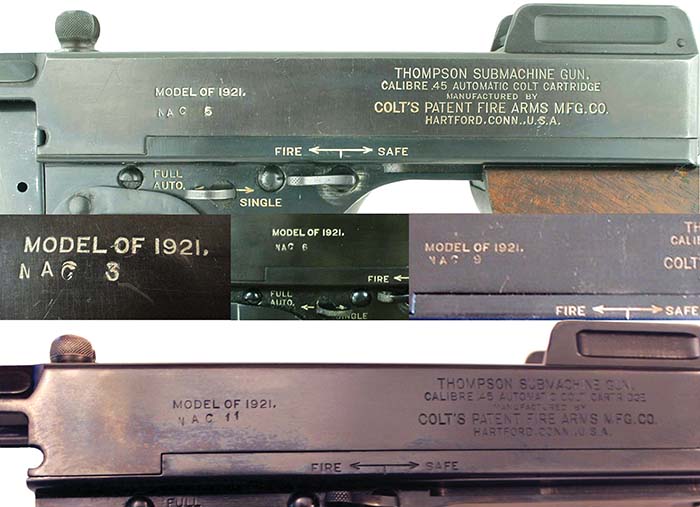
THE COLT NAC’S
NAC Thompsons with the Colt receivers are the culprits that caused most of the confusion in the Thompson community – and garner the most attention. For the uninformed, they appear just like an original Colt production Thompson. To complicate matters further, several Colt receiver variations have been observed. Imagine a so called Thompson guru that does not fully understand all the different Colt production receiver variants trying to explain the NAC variation to the uninformed. The most common Colt receiver variation for a NAC Thompson appears to be the last variation with the 1922 patent dates on the right side of the receiver.
Examination of FOIA documents from NAC Thompson guns indicate Numrich Arms sold a number of Thompson guns with Colt receivers to the Virginia State Police in 1953. These guns remained in police service for 21 years before being sold or traded to Class Three dealer J. Curtis Earl of Phoenix, Arizona.
The Class Three or machine gun community was very small during this time period. However, J. Curtis Earl soon became somewhat of a national celebrity. What brought Earl into such prominence with the American public were his advertisements and catalogs. He certainly understood the value of advertising and puffery; his prices for machine guns were at the top of the market. But Earl had something most of his competitors did not have – a very large inventory. And he showcased this very impressive inventory in a series of catalogs he sold throughout his career.
A review of a partial copy of Earl’s Firearm Dealer Bound Book revealed Thompson submachine guns with the serial numbers NAC – 2 through NAC – 15 were transferred to him on September 3, 1974 from the State Police in the Commonwealth of Virginia. The manufacturer for each one is listed as “COLT U.S.A.” with the model listed as “1921 THOMP” with the exception of NAC – 7, which is listed as a “1928-A1(1921).”
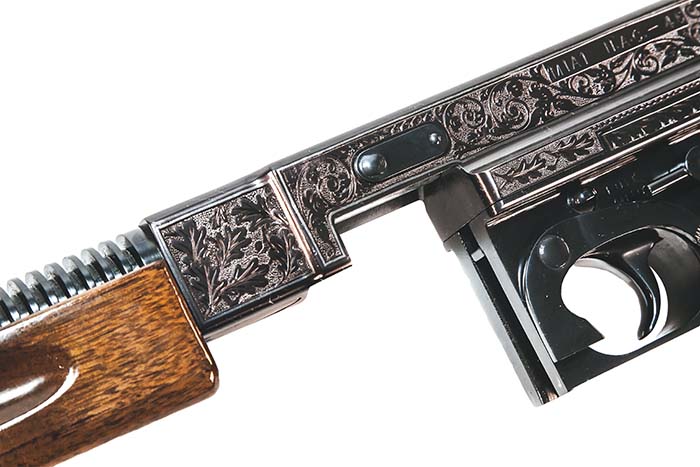
Unless otherwise noted, all the Thompson guns described in this story are in private collections. The following information is known about these 14 NAC Thompsons:
- NAC 2: NAC 2 was on display at the J. Curtis Earl Automatic Weapons Collection at The Champlin Fighter Museum in Mesa, Arizona for many years. Its disposition after the museum closed is unknown. Information released by Numrich Arms in 1996 revealed NAC 2, a Model 1921, was transferred to Numrich Arms in Mamaroneck, New York on December 1, 1951from Fred A. Willis, 25 Vanderbilt Avenue, New York, New York. NAC 2 was subsequently transferred to the Department of State Police, Richmond, Virginia on June 5, 1953.
- NAC 3: It is currently on display at the Idaho State Historical Museum, donated to the museum by the late J. Curtis Earl. It has a late Colt receiver with 1922 patent dates. FOIA information revealed NAC 3 was listed on an IRS Form 2, Return of Firearms Manufactured, Imported, Or Received By Manufacturer, Importer, Dealer (Other Than Pawnbroker), and Pawnbroker, Under Chapter 26, Subchapter B, Internal Revenue Code, as “manufactured, imported , or received” on December 1, 1951. Registration of NAC 3 was sent to the IRS by Numrich Arms on or about June 20, 1952.
- NAC 5: It has a late Colt receiver with 1922 patent dates. FOIA information revealed NAC 5 was listed as “manufactured, imported, or received” on December 1, 1951. Registration of NAC 5 was sent to the IRS by Numrich Arms on or about June 20, 1952.
- NAC 6: It has a late Colt receiver with 1922 patent dates.
- NAC 9: It has a late Colt receiver with 1922 patent dates.
- NAC 11: It has a late Colt receiver with 1922 patent dates. It has been professionally refinished to appear like a Colt production Thompson.
- NAC 15: The receiver is devoid of the normal markings but is believed to be of Colt manufacture. The receiver is hand-stamped on the left side toward the front: “M 1928” and “N.A.C. 15.” The top of the receiver is marked in three lines on the right side of the cocking slot: AUTO-ORDNANCE CORP. BRIDGEPORT, CONN. USA 45 CAL.
The frame is also unmarked except for the serial number, “NAC 15” and the letter “G” at the bottom of the trigger guard. FOIA information begins with the June 5, 1953 transfer to the Department of State Police in Richmond, Virginia. Apparently, the clerk in the ATF Disclosure Division could not locate the original IRS Form 2 as identified for NAC 3 and NAC 5, above. Information from Numrich Arms in 1996 shows the same past transfer history for NAC 15 as NAC 2, above, with the following additional information: NAC 15 is a Model 1928 and was originally transferred to Numrich Arms as a “Sample” marked “A.O.C.” and Numrich Arms “numbered it NAC 15.”
A continuous study of the NAC marked Thompson guns has revealed other Thompson guns with Colt receivers.
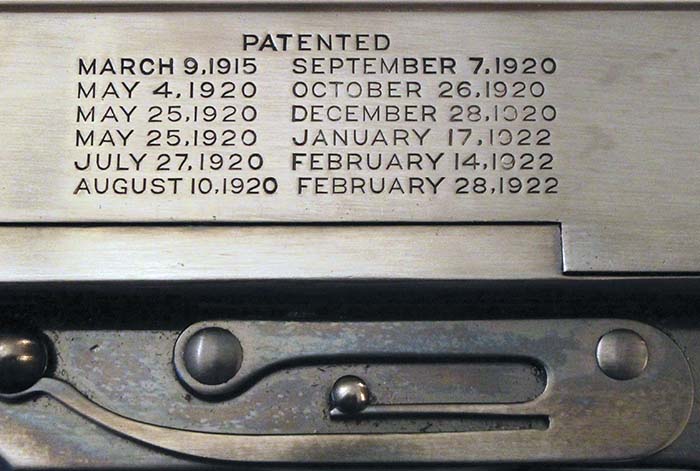
0049000 408 NAC: One can only imagine what IRS officials thought when Numrich Arms filed a Form 2 for this Model 1928 NAC Thompson gun with this serial number on June 21, 1968. The Colt era receiver is devoid of all markings except the serial number and the Auto-Ordnance early trademark logo, AUT-ORD-CO-, found at the top of the early square actuator slot receiver. This NAC Thompson has been professional refinished in the Model of 1928A1 format and is mated with a Savage Arms frame. There is no reason to believe this Thompson gun is not one of the original crate guns even though it was not registered with the IRS until much later.
533 NAC: This Colt era receiver also features the Auto-Ordnance early trademark logo, AUT-ORD-CO-. It has the commonly found patent dates ending at December 28, 1920. The standard model and serial number nomenclature markings are missing and the remaining factory markings are very weak. The serial number is hand stamped on the upper left side of the receiver toward the front. The frame has a Savage Arms serial number.
When other NAC guns within the serial number range of 1 through 15 are examined more information on these early numbered NAC guns may be obtained. All the NAC Thompson guns with Colt era receivers appeared to have been assembled with left over Colt and WWII parts to make complete submachine guns. No one is alive today that can describe exactly what parts were used and why. Suffice to say, there was no standardization of parts from one gun to the next. It appears whatever parts first found and available were used. The goal of Numrich Arms was to make a marketable product.
The NAC story is far from complete. Part Two of The NAC Thompson Guns will be presented in an upcoming issue of Small Arms Review!
| This article first appeared in Small Arms Review V20N6 (July 2016) |



